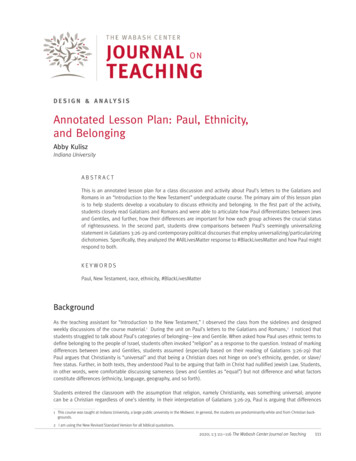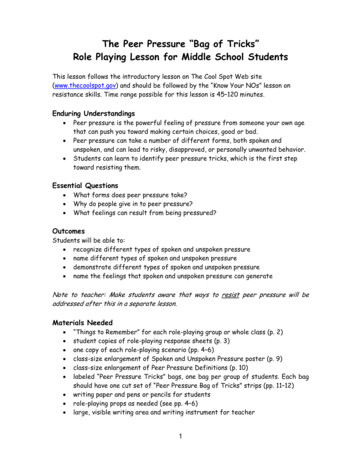![Ecosystems 5E Lesson Plan For Grades 3-5 [PDF]](/img/22/ecosystems-lesson-plan-gg.jpg)
Transcription
LESSON PLANLink to VideoECOSYSTEMSGRADES 3-5SUMMARYIn this activity students learn that an organisms can only survive in an ecosystem where its needs are met. They explorea variety of different ecosystems and study the interaction between living things and non-living things, such as soil,water, and air. They also think about changes in ecosystems and the impacts they have on living things.CORRELATION3-LS4-3. Construct an argument with evidence that in a particular habitat some organisms can survive well, somesurvive less well, and some cannot survive at all. [Clarification Statement: Examples of evidence could include needs andcharacteristics of the organisms and habitats involved. The organisms and their habitat make up a system in which theparts depend on each other.]3-LS4-4. Make a claim about the merit of a solution to a problem caused when the environment changes and thetypes of plants and animals that live there may change.* [Clarification Statement: Examples of environmental changescould include changes in land characteristics, water distribution, temperature, food, and other organisms.] [AssessmentBoundary: Assessment is limited to a single environmental change. Assessment does not include the greenhouse effector climate change.]Science & Engineering PracticesEngaging in Argument from Evidence (3-LS4-3,3-LS4-4)Other Science and Engineering Practicesaddressed by this lesson:Analyzing and Interpreting DataConnections to Classroom Activity Students present an argument based on evidence related to how a change might affect an ecosystemor organisms from that ecosystem.Students observe and interpret relationshipsbetween living and non-living components ofecosystems. 2018 GENERATIONGENIUS.COM1
Disciplinary Core IdeasLS4.C: AdaptationFor any particular environment, some kinds oforganisms survive well, some survive less well, andsome cannot survive at all. (3-LS4-3)LS2.C: Ecosystem Dynamics, Functioning, andResilienceWhen the environment changes in ways that affecta place’s physical characteristics, temperature, oravailability of resources, some organisms survive andreproduce, others move to new locations, yet othersmove into the transformed environment, and somedie.(secondary) (3-LS4-4)Connections to Classroom Activity Students observe several ecosystems and the organisms within those ecosystems that survivewell.Students explore which organisms survive wellwithin certain ecosystems and which cannot survivein certain ecosystems.Students recognize how changes in certainecosystems might affect organisms that live there.LS4.D: Biodiversity and HumansPopulations live in a variety of habitats, and changein those habitats affects the organisms living there.(3-LS4-4)Crosscutting ConceptsCause and Effect (3-LS4-3)Systems and System Models (3-LS4-4)Connections to Engineering, Technology, andApplications of ScienceInterdependence of Engineering, Technology, andScience on Society and the Natural World (3-LS4-4)Connections to Classroom Activity Students recognize effects of certain positive andnegative human actions. Students study the effect of changes to anecosystem. Students recognize that an ecosystem is a systemthat is described in terms of its components andtheir interactions.PRE-ASSESSMENT QUESTIONSPlease see Discussion Questions located under the video. These can be discussed as a group or answered individually instudent science notebooks.ENGAGEBring in a photo of an animal or plant from the ecosystem where you live or a nearby ecosystem with which the studentsare familiar. Ask students, what does this animal or plant need to survive? Does it rely on other animals for survival? Doesit rely on plants? What about non-living things?Explain to students that in this lesson they will be thinking about how living things interact with other living and non-livingthings to survive in an ecosystem.2 2018 GENERATIONGENIUS.COM
EXPLOREGive each student one of the Ecosystem ConnectionCards located at the end of this document. Havestudents get up and find other students in the roomthat have the same color card as they do (this willlead the students to form groups of 3-4). Havestudents sit with their group and discuss how thedifferent things on the cards interact. They shouldwrite about the connections and interactions betweenthese living and non-living things in their sciencenotebooks individually based on group discussion.When all groups have discussed on their own, alloweach group to share the connections they foundbetween the living and non-living components ontheir cards with the rest of the class.MATERIALS Ecosystem Connection Cards (color print & cut) Science notebooks PencilsDIY Activity Large glass jar with a lid Mesh (optional) Scissors Rocks or gravel Activated carbon (from a pet / aquarium store) Spray bottle of water Plants growing in soil Moss growing in soil Extra soil SpoonEXPLAINWATCH THE GENERATION GENIUS ECOSYSTEMS VIDEO AS A GROUP.Then facilitate a conversation using the Discussion Questions.Return to the discussion using the ecosystem cards. What kind of ecosystem do their group’s cards represent? Whatother components are there in that system? How do they interact? Give each group their Ecosystem Change Question,also located at the end of this document (same color). Ask them to consider this change related to the ecosystem theyhave been discussing. Allow them to discuss as a group and then share their ideas with the class.ELABORATEUse the DIY Activity to create a class terrarium just like Zoë’s from the video. Make a schedule for students to take turnsobserving the terrarium over the next few weeks to make sure the ecosystem is in balance and the components aresurviving. Make adjustments as necessary.EVALUATEProvide students with another group of living and non-living things from an ecosystem (similar to Ecosystem ConnectionCards). Individually in their science notebooks each student should list 2-3 ways these components interact in theecosystem. You might also provide a scenario similar to the Ecosystem Change Question and give students theopportunity to answer in a few sentences. 2018 GENERATIONGENIUS.COM3
EXTENSIONSHave students observe a nearby park, garden, or even their schoolyard. What are the components of that ecosystem?How do they interact and depend on each other? How have humans impacted the ecosystem? Define limiting factorsas components of an ecosystem that keep populations to certain numbers. Ask students what limiting factors mightkeep populations down in your area (predators, construction, roads, seasonal changes).4 2018 GENERATIONGENIUS.COM“Next Generation Science Standards” is a registered trademark of Achieve, Inc.A non-profit dedicated to raising academic standards and graduation requirements.Lesson plan written by Mountain Goat Instructional Design.
ECOSYSTEM CONNECTION CARDS AND CHANGE QUESTIONSBeeTulipSoilSunCould aTulip survive ina river ecosystem?RoseButterflySoilSunCould a butterflysurvive if thetemperaturegot much colder?FrogPondRocksMosquitoesCould a frogsurvive if the ponddried up?SunLizardCactusSoilCould a lizardsurvive in thesnow?Panda BearBambooSunSoilCould a pandabear survive in thearctic?AntsSoilGrassSpiderCould ants survivein the ocean?RocksCould a troutsurvive if the rivercontained saltwater?River(fresh water)TroutSmall FishEagleSquirrelOak TreeSoilCould the squirrelsurvive if oak treeswere replacedby palm trees?CoralTropical FishCrabsRocksCould tropical fishsurvive if the coraldies?Salt WaterWhaleSharkFishCould a whalesurvive in thedesert?SoilCould the owl,mice and treesurvive if the soilwashed away?Pine TreeOwlMice 2018 GENERATIONGENIUS.COM5
Ecosystems 5E Lesson Plan for Grades 3-5 [PDF] Subject: This 5E Lesson plan for grades 3-5 helps elementary school students learn about ecosystems. Includes an activity, video, readin










